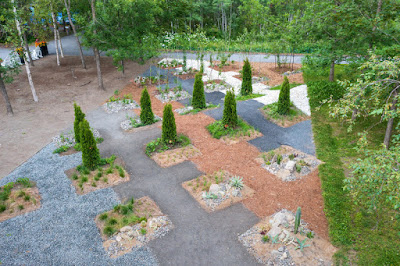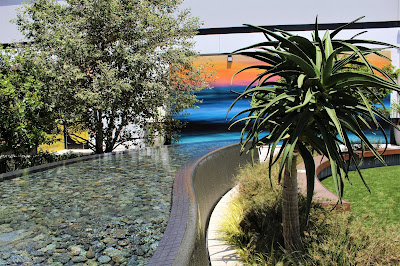Sunday, August 22, 2021
Forest Bathing and Forest Therapy
The Ficus Forest at the Fullerton Arboretum. Photo by Myriam Mahiques, personal archives. 2021
I love walking in forests, it is so calming.... Apart from concentrating on photography, I enjoy the smells and the textures, feeling the sound and textures of leaves below my feet.
I have attended an online conference a few days ago promoted by Japan House in Los Angeles:
Guest speakers were Dr Iwao Uehara and Forest Therapy Guide Ben Page. From the introduction:
"During the pandemic, restrictions have kept many people indoors and masked when outdoors. Now that more people in the US are feeling safe in outdoor spaces and are breathing fresh air without a mask again, there is a sense of reconnecting with nature, its beauty and its healing qualities. In order to maintain physical, mental and emotional balance as they re-enter “normal.” life, many Americans are looking for new ways to connect with nature.
Healing through close contact with nature is at the core of the Japanese concept of “Shinrinyoku” or “Forest Bathing,” a term coined in the 1980s by the Japanese Ministry of Agriculture, Forestry and Fisheries to encourage citizens to take walks in the forests. Japanese researchers have discovered many positive physiological effects of walking in nature, including lower heart rate and blood pressure, strengthened immune systems and a reduction in depression.
Professor Iwao Uehara, who founded the practice of Shinrin-ryōhō, or “Forest Therapy,” in which the health of the forests is also considered, and Ben Page, a local expert in forest bathing, will discuss the philosophy and benefits of forest bathing and forest therapy in Japan and worldwide."
From my notes on the conference:
"Forest bathing" (1982) is like bathing in the sea, but we are surrounded by the forest instead. How it feels, it depends on the person and the forest the person selects.
"Forest therapy (1999): the difference is a group of people is guided, usually to meditate, to heal, to interact with nature. There are activities involved to improve the forest, like (for example) clearing of overgrown plants and planting of species.
Some goals of Forest Therapy: rehabilitation of patients with dementia, avoid stress, avoid suicides, discover the local environment, improve people's relationships, counseling for depression.
The practice has to be done in natural environments without human intervention, not in gardens with trees planted by humans. It is not the same to walk around the neighborhood.
Ben Page explained Forest Therapy is being implemented in USA, but it is a Western interpretation of the Japanese therapy. He mentioned an interesting comparison between cultures:
While Westerns say "we have to conquer the mountain", Japanese say "we have to be friends with the mountain".
Forest Therapy is preventive, not a curative discipline. It is to improve the wellbeing.
A nurse relaxing in a beech forest. Photo posted by Japan House illustrating the conference.
There is much more to read and I leave a few links here:
From the International Garden Festival 2021
Porte-Bonheur. D. Bonnard, DE HMONP arch., L. Giuiliani, landscaper, A.Viale, visual artist. France.
Photo credit JC Lemay
Porte-Bonheur. France
I am sharing from V2com newsletter the projects which I consider more relevant in hardscape-landscape design.
The first picture, see how interesting the abstract design and color as a center of interest in the middle of the forest. The "doors" are inviting to walk around, some open, some shut, creating a sort of "labyrinth".
The next one, it is a great idea of the deconstruction of a children's house. I have seen so many of them installed in backyards, standard children's houses just bought and installed like objects. This is quite different.
The striking blue and the geometry in three dimension must trigger creative ideas in children who play with it and recreate the "house" as an abstract concept.
It is important to note the organic geometry of the planters and path around the regular Euclidean of the house. The windows on the ground, as planters, are such an intelligent solution.
Open Space legaga (G. Lemelin, F. Gaignard, S. Gaulin, architectural interns). Canada
Open Space legaga. Canada
Open Space legaga. Canada
Choose your Own Adventure. Balmori Associates (n. Lafaurie-Debany, J. Gonzalez-Campana, S. Escabi, C. Liao, C. Preciado, landscapers and urban planners). New York, USA.
Photo credit J C Lemay
This last one, I like the geometric design of the ground and paths, the green around, the overall colors. The mix with the organicism and Euclidean geometry. The different heights in 3D.
Saturday, August 14, 2021
The Manhattan Village Fountain
I am sharing this fountain design in Manhattan Village Mall which I find very interesting. When we think of a fountain, the first image that comes to our mind is a round shape, because this the typical historical fountain, or the standards on sale. But this one is designed in order to create a sort of path, though narrow, I could walk around. I don't remember if there was enough width for a wheelchair between the fountain and the hemicycle across the path, it seems not, an accessible path would have been a better solution to allow everybody to enjoy how it feels to walk or stroll along the landscape. It changes the perception of the hardscape related to nature.
I really like the pebbles at the bottom and the tree reflection on the water. It looks like the tree is emerging from the fountain, but it is not. The tree area is inviting to have a rest under the shadow, see the mall is very open and the sun hits very hard.
We can see here that the side path is not accessible, but maybe it was created just to have a technical separation between the fountain and the plants. People do not walk along the fountain but around and the effect of the "in between" water and plants is lost. Anyway I like the overall design.
All pictures by Myriam Mahiques, personal archives, May 2021. Please do not share without permission.
Sunday, August 8, 2021
Lacebark tree
Lacebark tree. Photo by Myriam Mahiques, personal archives 2021
Every Summer I go to the park specifically to take pictures of this fantastic ornamental tree, Brachychiton Discolor. The pink flowers look like velvet, they do not have petals, it is just a single morphology arranged in beautiful clusters. The roasted seeds are edible but I have never tried them. I am just focused on the clusters.
All pictures by Myriam Mahiques, please do not share without permission.
Thursday, August 5, 2021
Dead Almond Trees
Photograph: Robyn Beck/AFP/Getty Images
I have seen dead plants and trees due to droughts, fires, and also the Water Department's restrictions on watering. But this is such a striking photo I'm sharing here. It looks like an abstract painting, so Surreal it looks. From The Guardian:
"Dead almond trees lie in an open field after they were removed by a farmer because of a lack of water to irrigate them, in the drought-stricken Central Valley. Distraught by the drought and new water restrictions, the Californian farmer had no choice but to uproot 150 hectares (371 acres) of his ‘premium’ trees" How bad and frustrated the farmer must have felt. Learn more about the Almond tree, from which we enjoy the seed:
Subscribe to:
Comments (Atom)
Sound Atmosphere After the Wildfires
The silhouette of a crow standing on the remnants of a house in Altadena. Photo by Myriam Mahiques, March 2025. Each neighborhood an...

-
I have been navigating the City of Monrovia web page, looking for contact phones, and I came across with this interesting information abou...
-
The Norton Simon Museum is celebrating its 50th Anniversary this year and it deserves a post. I visited this Museum in 2023 with my son, wh...
-
Entering Gas Works Park, Seattle. All photos in this post belong to my personal archives. June 2024. I had read about Gas Works Park in a Th...
























